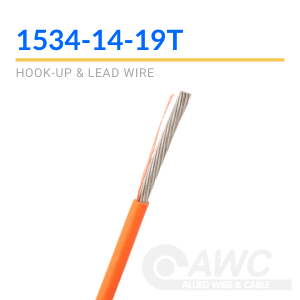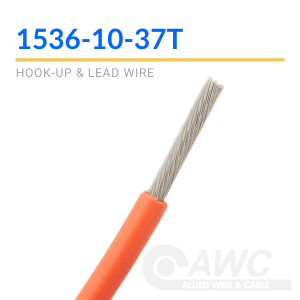UL 1429 Wire Explained
UL-approved appliance and hookup wire UL 1429 uses irradiated cross-linked polyvinyl chloride (PVC) insulation. This process changes the properties of PVC from a thermoplastic that softens and burns when heated to a thermoset polymer that does not become soft or burn when heated. UL 1429 wire has a 150-volt rating and a maximum operating temperature of 80 °C. This wire also meets the requirements of the military specification MIL-W-16878/1.
16 items
-
1429-20-19T$0.00 / 1000 FT
- Approx LBS/MFT: 5.00
- AWG Size: 20
- Cond. Material: Tinned Copper
-
1429-20-7T$0.00 / 1000 FT
- Approx LBS/MFT: 5.00
- AWG Size: 20
- Cond. Material: Tinned Copper
-
1429-18-19T$0.00 / 1000 FT
- Approx LBS/MFT: 6.00
- AWG Size: 18
- Cond. Material: Tinned Copper
-
1429-18-7T$0.00 / 1000 FT
- Approx LBS/MFT: 6.00
- AWG Size: 18
- Cond. Material: Tinned Copper
-
1429-16-19T$0.00 / 1000 FT
- Approx LBS/MFT: 10.00
- AWG Size: 16
- Cond. Material: Tinned Copper
-
1534-14-19T$0.00 / 1000 FT
- Approx LBS/MFT: 14.00
- AWG Size: 14
- Cond. Material: Tinned Copper
-
1536-12-19T$0.00 / 1000 FT
- Approx LBS/MFT: 23.00
- AWG Size: 12
- Cond. Material: Tinned Copper
UL 1429 Wire Construction
This wire has a single copper conductor covered by cross-linked PVC insulation (XLPVC). It doesn't usually have a jacket, although the UL 1429 standard allows for one.
The wire has tinned copper conductors that facilitate soldering. Conductors may be solid or stranded. Unusually within a UL standard, you have a choice between more rigid conductors with fewer strands and flexible conductors that have a higher number of smaller copper wire strands. This applies to wire thicknesses between 26 and 18 American Wire Gauge (AWG).
The wire insulation is XLPVC with a nominal wall thickness of 0.01 inches. The irradiated PVC insulation has good mechanical properties, especially strength and cut-through resistance. XLPVC has good flexibility, chemical, and solvent resistance.
UL 1429 Applications
Applications for UL 1429 wire include low voltage lead and hookup wire in electronic equipment, computers, control systems, and appliances. The good mechanical properties make the wire suitable for use on high-speed automated cutting and stripping machines. The wire is flexible and easy to use in tightly packed electronic equipment boxes.
UL 1429 Specifications and Approvals
In terms of UL testing and approvals, the following apply:
| Voltage Rating: | 150 volts |
| Maximum Temperature: | 80°C |
| Minimum Temperature: | -55°C |
| UL 1429: | Complies |
| Canadian Standards Association (CSA): | Appliance wiring material (AWM) | AB FT1 |
| Flame Retardant Ratings: | FR-1 and newer VW-1 vertical flame test |
| Restriction of Hazardous Substances Directive (RoHS): | Complies |
MIL-Spec MIL-W-16878/1 Compatibility
UL 1429 wire from AWC complies with military specification MIL-W-16878/1, which infers somewhat higher properties than under UL 1429. These include:
- Voltage rating: 600 volts
- Maximum temperature: 105°C
- Minimum temperature: -55°C
What's the Difference Between PVC and XLPVC Insulation?
Standard polyvinyl chloride insulation is a thermoplastic, whereas cross-linked PVC is a thermoset material. Standard PVC insulation softens when heated and also shrinks. This effect is particularly noticeable when soldering with a hot soldering iron. What happens is the insulation pulls back and distorts, exposing the conductor. Another feature of standard PVC insulation is that the insulation tends to stretch when you're using a wire stripping tool, so it is more difficult to get a clean cut. XLPVC does not shrink or burn when heated, facilitating a neat, soldered joint. Also, because it doesn't stretch easily, it is more suited for use in automated wire stripping equipment.
Can You Use UL 1429 Wire Above 150 volts?
It depends. If you're wiring equipment to the UL Appliance Wiring Material standard (UL 758), you may not use it for circuits above 150 volts. In most circumstances, this would also apply to equipment covered by the National Electrical Code (NEC). If you're wiring equipment in terms of military standards, yes you can, because the MIL-W-16878/1 specification allows its use on voltages up to 600 volts.








